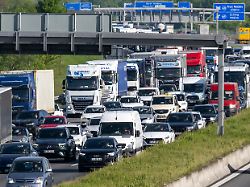Up to 9.7 trillion euros
Traffic turnaround can be very expensive if there are delays
May 13, 2024, 11:06 a.m
According to a study, the costs of the transition to climate-neutral transport will increase significantly if politicians do not act more ambitiously in this area. However, if you act faster, billions could be saved.
According to a study, the longer politicians hesitate to take measures for climate-neutral transport, the more expensive the transport transition will ultimately become. “Political hesitation has a price,” says the analysis by Agora Verkehrswende, a non-profit organization for scientific policy advice. “The price is measured either in money or in greenhouse gases, with all the associated risks.” However, with a timely, ambitious climate policy for the transport sector, the federal government could even save something compared to a business-as-usual transport policy.
In the study, the organization examined three different scenarios with different levels of climate protection measures in the transport sector. The current transport transition policy served as a reference scenario, including planned but not yet decided measures.
“In this reference scenario, greenhouse gas emissions from transport will fall to 111 million tons by 2030 and to around 15 million tons by 2045,” the authors write. This means that both the climate target for the transport sector for 2030 and the zero emissions target for 2045 will be missed.
Study depicts different scenarios
Two further scenarios are based on the assumption that more ambitious climate protection programs will be launched from 2025 (“Turnover 2025” scenario) or from 2030 (“Turnover 2030”). In these two variants, climate neutrality in transport would be achieved by 2045. However, the “Turnover 2030” scenario would involve significantly higher expenses – even in comparison to the reference scenario, in which everything remains as it is currently. Ultimately, more efforts would have to be made there in a shorter period of time in order to achieve climate neutrality.
All three scenarios assume the same amount of mobility. However, depending on the variant, this is distributed differently across the individual modes of transport. Public transport – i.e. bus, train, bicycle and walking traffic – plays a significantly larger role in the 2025 and 2030 scenarios in the long term than in the reference scenario. The importance of car traffic will even increase there by 2045. The focus here is not on reducing car traffic, but on replacing combustion engines with electric drives.
The electric share in the “Turnover 2025” scenario is significantly higher than in the reference scenario and highest in the “Turnaround 2030” variant. However, both paths assume a significant reduction in private motorized transport.
There is a risk of trillions in costs
If the federal government were to let everything continue as before, it would have to spend around 9.7 trillion euros on the transport transition by 2045 – including indirect costs for climate damage as a result of further CO2 emissions. Despite this enormous sum, it would miss the climate targets in the transport sector. It would be a little cheaper if it took measures from 2025 at the latest with which the zero emissions target in transport could be achieved within the next 20 years. Due to the lower climate damage, the government saved around 60 billion euros in this scenario.
A redirection will be significantly more expensive from 2030 onwards. The climate target could still be achieved then. However, this would require greater and, above all, more expensive efforts. The federal government would have to spend more than half a trillion euros more on this compared to the situation in which nothing changes to the planning.
“If we act quickly and decisively, the transport sector can become climate neutral by 2045,” said the deputy director of Agora Verkehrswende, Wiebke Zimmer. “This can be achieved without additional costs in the period up to 2045.” Initially, higher investments are needed, but overall no more money. “Above all, more political will is needed,” emphasized Zimmer.
